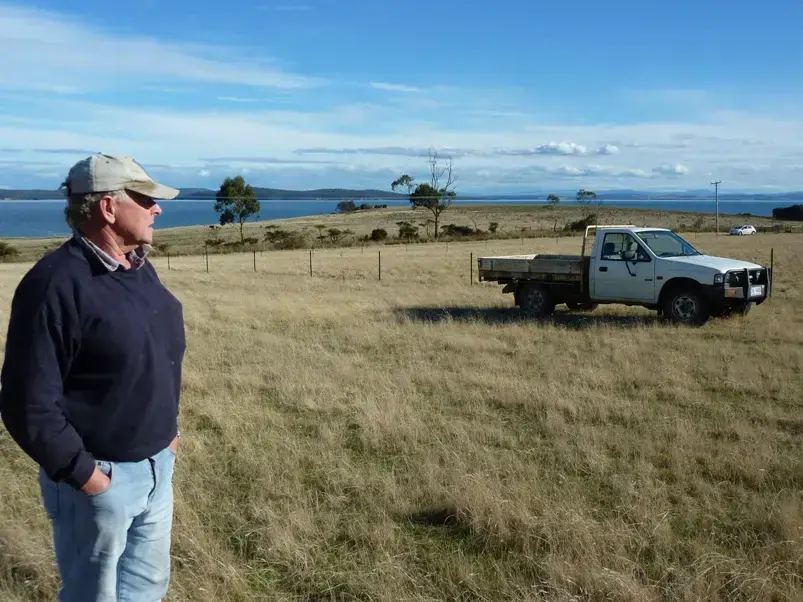‘NRM South‘
A REGENERATIVE AGRICULTURE CASE STUDY
 The team at Tasmania’s NRM South are tailoring solutions to meet the needs of landholders in their catchment and are offering low risk trials for farmers willing to try new land management practices.
The team at Tasmania’s NRM South are tailoring solutions to meet the needs of landholders in their catchment and are offering low risk trials for farmers willing to try new land management practices.
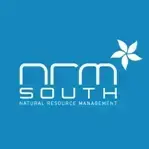 The team at Tasmania’s NRM South are tailoring solutions to meet the needs of landholders in their catchment and are offering low risk trials for farmers willing to try new land management practices.
The team at Tasmania’s NRM South are tailoring solutions to meet the needs of landholders in their catchment and are offering low risk trials for farmers willing to try new land management practices.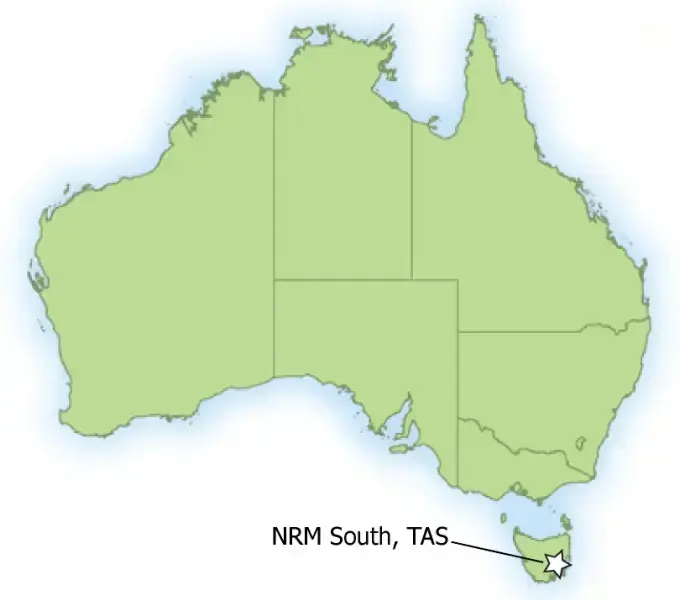
Southern Tasmania
FARM FACTS
ENTERPRISE: Grazing, cropping, perennial horticulture and other sectors
AVERAGE ANNUAL RAINFALL: 400-2400 mm
ELEVATION: Sea level to 1450 m
SOILS: Varied, on dolerite, mudstone and sandstone, ranging from podzol, podzolic to brown, black and alluvial
NATIVE VEGETATION COVER: 60-70% on average, less than 50% in the Jordan catchment (mostly within the Southern Midlands municipality)
INNOVATIONS
- Engaging farmers through supported activities to encourage trial and adoption of regenerative landscape management
- Tailoring support to land manager requirements
- Activities commenced: 2010
KEY RESULTS
- Farmers adopting trials of planned grazing
- Gaining a sound understanding of farmers’ interests in improving their landscape
- Developing the ability to set-up and monitor farm trials
- Exceeding engagement targets
Introduction
Southern Tasmania’s natural resource management organisation, NRM South, has determined that the best way to encourage regenerative land management practices in their region is to give farmers what they want. Surveys of landholders participating in the Woolworths drought landcare project showed that soil health, pasture management and irrigation were the areas of most interest to farmers in NRM South’s region. Understanding that everyone is at a different stage of learning, with different priorities for the management of their land, the team at NRM South has developed a range of activities and learning strategies most suited to individual landowners to improve knowledge and practice in these areas. Their methods provide a model of coordination and cooperation for organisations helping landholders to embrace change in land management.
The NRM South Sustainable Farm Practices program has two components: Living Soils delivers education, engagement and support, and Building Evidence for Regenerative Agriculture incorporates a range of projects to develop a body of evidence for the application of low input, biological farming practices in southern Tasmania. Central to this, NRM South is working with farmers to perform monitored trials, particularly in holistic planned grazing. With comprehensive support and guidance, willing participants are learning new methods and obtaining evidence to help them decide whether to adopt new practices on their land.
With a focus on landscape health, NRM South is providing tools to help identify and support farming goals through an approach that targets outcomes across the triple bottom line – social, environmental and financial.
ABOUT NRM SOUTH
NRM South is the natural resource management body for southern Tasmania and engages with government, business, scientists and the community to protect and manage the natural assets of the region.
The Southern Tasmanian NRM Region covers 2.5 million hectares, including Hobart, its urban fringes and numerous towns and hamlets, and supports almost half of Tasmania’s population of 500,000. It spans the twelve urban and rural municipalities of Brighton, Central Highlands, Clarence, Derwent Valley, Glamorgan Spring Bay, Glenorchy, Hobart, Huon Valley, Kingborough, Sorell, Southern Midlands and Tasman and the state and federal electoral divisions of Franklin, Denison and roughly one third of Lyons. NRM South has five priority areas for investment in its region, established on the bases of threats to natural assets and community readiness.
Approximately 1200 landholders reside in the NRM South region, however, due to the nature of the region, only 12% of these consider themselves full-time farmers. Around 240 landholders have some form of active engagement with NRM South.
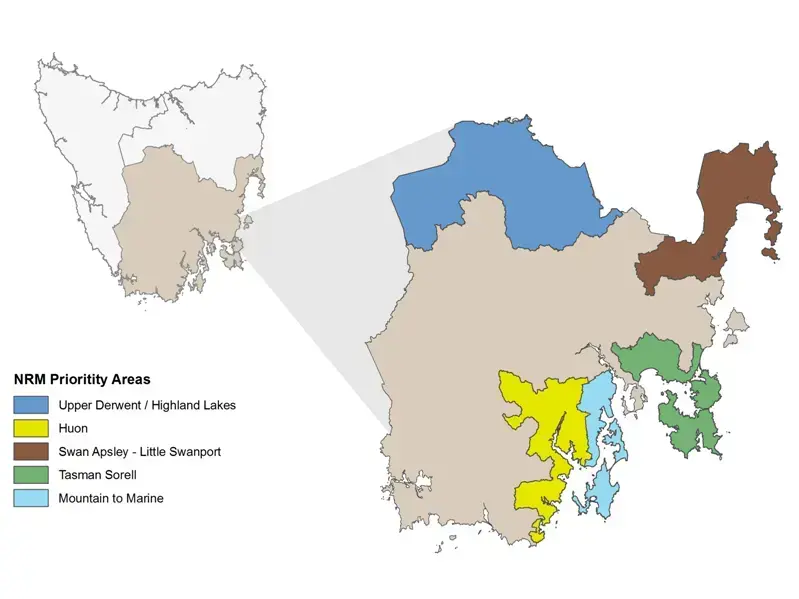
The NRM South region
Eighteen staff work at NRM South implementing a range of programs, projects and initiatives. These activities seek to address the corporate priorities, namely:
- Develop and share knowledge of the region’s natural resource condition, values and threats
- Build partnerships and engage the community in positive action
- Deliver on-ground and sustainable practice programs in priority areas
- Optimise the use of available resources for NRM and secure additional resources
- Govern and manage the NRM South business effectively
Changing Practices
TAILORING SUPPORT
Group processes are powerful learning experiences.
NRM South engagement activities aim to develop “a productive and ongoing relationship based on mutual respect, trust and benefit”. Central to this is jointly meeting landholder and NRM requirements. NRM South understands that the landholders in their region have varying motivations and needs. Dr Magali Wright, the NRM South Biodiversity Coordinator, points out, “People are at different places [with their land management practices and knowledge] and need different things”. This understanding has led NRM South to tailor their information and support as much as possible within their available resources to meet landholder needs.
Using their base funding from the Australian Government’s Caring for Our Country program and funding from the Federal Department of Agriculture, Fisheries and Forestry, the team at NRM South have developed a range of activities to meet these goals.
Drawing on survey information that showed that soil health, pasture management and irrigation were the areas of most interest to landholders in the region, information and activities are targeted to address these areas, but always within the context of overall environmental, economic and social health. The team at NRM South attempt to provide broader land health solutions to address specific problems being experienced by landholders (for example, weed invasion), to better support triple bottom line outcomes.
The ability of the local facilitators, who work in each of NRM South’s priority areas, to build relationships in local communities is essential to the success of the program. They initiate engagement with landholders through advertised workshops or field days and one-on-one farm visits. Interest in regenerative farm practices is also spread more broadly through word of mouth between the range of long-term landowners, sea-changers and tree-changers which comprise the region’s populations.
Living Soils
LIVING SOILS
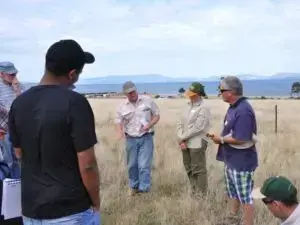
Landholder visits provide the opportunity to share experiences
Living Soils activities provide a range of methods of education, engagement and support. The team attempts to manage activities that best engage landholders and facilitate communication. Workshops and field days are fundamental to the program. Barry Hardwick, the Regional Landcare Facilitator notes, “Group processes are powerful learning experiences. As are visiting other landholders to share experiences”.
The Living Soils workshop series addresses a range of methods and techniques including but not limited to Keyline ploughing, compost, compost teas, holistic planned grazing and pasture cropping. Local facilitators also deliver workshops addressing issues such as weed management, salinity, tree decline, erosion, pasture decline, soil health and native grass management. On farm visits are also performed, providing advice and action planning with expert consultants or advice and support from local facilitators.
NRM South also supports existing farmer groups in the region and facilitates the formation of new groups to further spread their engagement and enable information sharing.
On-Farm Action grants are available as an alternative method of supporting engagement and practice change, These have received strong interest from the community and further extends NRM South’s reach. These incentives provide financial and in-kind support for various areas of landscape regeneration, such as weed management, biodiversity and riparian protection. The On-Farm Action grants encourage co-investment from landholders and align with available service provision and ongoing support advice or activities from local facilitators.
LIVING SOILS CONTRIBUTES TO
SUSTAINABLE MANAGEMENT OBJECTIVES & MEASURES
- Promote and support the uptake of sustainable management practices, attain 20% uptake
- Promote innovation in agriculture
- Build evidence in the application of sustainable practices in a Tasmanian context as an engagement mechanism
- Engage 400 landholders with the program
- Support practice change in 60 landholders
- Measure area (hectares) under improved management
- Measure the amount and type of resource condition and change monitoring conducted
Living Soils is a key project delivered through the Regional Landcare Facilitator role. As at December 2011, halfway through the three-year project, it has:
- assisted 43 landholders to prepare action plans to improve the environment both on-farm and off-farm, from a target of 60
- provided advanced training activities on sustainable farm and land management practices that deliver improved ecosystem services to 116 landholders, from a target of 360
- engaged 452 landholders through workshops and field days, already exceeding the three year target of 400.
The team want their projects to empower and build capacity in their landholders, rather than relying on external supports. In Barry’s words, NRM South wants to help landholders “To find their own solution for their business, for their property, for their family, for their community”.
NRM South is continuously learning from their activities to improve their services and the outcomes in their region. Cathy Limb, the Communications and Engagement Manager, knows that many activities, “Develop and support passion in the land managers”, but that, “follow up is critical – to maintain the momentum.”
To support this, NRM South are moving from the previously typical short-term individual projects, to longer term activity planning to gain continuity of outcomes, including ongoing engagement, support and empowerment.
Evidence for regenerative Agriculture
BUILDING EVIDENCE FOR REGENERATIVE AGRICULTURE
Trials are a low-risk approach.
To encourage landowners to adopt new regenerative practices and holding a long-term view to landscape regeneration, NRM South has developed the Building Evidence for Regenerative Agriculture projects.
The primary objective of the Building Evidence trial sites is to demonstrate the application of regenerative agricultural practices on farms in the southern Tasmanian region. The evidence collected through the trials will be used to support farmers interested in these techniques and improve the sustainable management of natural resources on their properties. These are successful in bringing farmers on board, because, as Cathy points out, “Trials are a low-risk approach”.
The experience of team members at NRM South has shown that changing thinking is a very challenging process for some landholders, whereas others find it easier. Only having to commit to a trial helps to ease some farmers into new practices and allows them to test these out for themselves.
The Building Evidence trials ultimately aim to bring landscape change across southern Tasmania grazing land and improve landscape function, in particular retention of resources in the landscape and improved water and nutrient cycling. Holistic planned grazing was selected as the trial method, as improved grazing regimes have the potential to lead to large scale change – a large proportion of private land in the NRM South region is grazed. Many threats to the region’s natural assets have also been linked to inappropriate grazing practices.
The trials follow principles that build on the concept of ‘holistic decision making’ which provides tools to help identify and support farming goals across the triple bottom line – considering economic, social and environmental aspects. The trials incorporate holistic planned grazing treatments with a focus on dealing with causes of land management issues, not the effects or symptoms. They aim to develop skills to improve soil health and landscape function.
The short to medium term outcomes of the Building Evidence trials are communication, engagement and capturing qualitative and quantitative data based on changes in pasture and soil resources. In the longer term, in addition to ongoing communication and engagement, the project aims to provide a research base, and the potential for scientifically rigorous comparisons to reference sites.
Over 25 trial sites have been established across the region, with a number of other less formal trials taking place on other farms. Fifteen of the trials are undergoing formal monitoring processes, and five have been set up as demonstration sites. Ongoing monitoring and evaluation is helping to identify issues and is an integral part of the project.
NRM South staff are now building sufficient skills to set up trials on farms, reducing previous reliance on consultant support. This both assists with minimising expenses and helps achieve credibility and trust from landholders.
Approximately six staff work on the Living Soils and Building Evidence projects, however, most of these also have other responsibilities, so all are on a part-time basis, ranging from around one to three days a week on the project. Budget allocated to the projects vary each year, depending on the activity and focus. In Financial Year 2011-12, $76,000 has been allocated to Living Soils and $70,000 to the Building Evidence for Regenerative Agriculture project. These figures do not include salary components.
BUILDING EVIDENCE FOR REGENERATIVE AGRICULTURE
OBJECTIVES & MEASURES
- Encourage improved grazing management in southern Tasmania
- Trial the effectiveness of planned grazing to address a range of land management issues and landscape goals with landholders willing to host long term demonstration sites
- Establish 5 sites in 2010-11 and 10 new sites in 2011-12
- Monitor results of resource condition improvement
- Record how many landholders extend the practice beyond trial scale
The participants
THE PARTICIPANTS
Building Evidence for Regenerative Agriculture trial participants are private landholders with different enterprises, values, land management issues and production. The majority are conventional agricultural enterprises, however there are also two organic farms with conventional grazing regimes. Each landholder is trialling the use of holistic planned grazing on a small half to one hectare paddock. However, Barry reports, “A number have gone to whole of farm first up”, with two landholders making a full transition to holistic planned grazing across their entire properties.
All of the 15 trial sites with formal monitoring have poor landscape function and most have been selected to focus on the poorest soils and pastures on the properties. The trial sites have been set up to address a range of land management issues including herbaceous and woody weeds, salinity, soil erosion, poor ground cover and water-logging. Water cycling is an issue on all sites.
The trial locations range from costal scrub to wet forest, however the majority would originally have been grassy woodland. All sites comprised degraded native or introduced pastures and would have previously functioned more effectively. Some sites contain or are linked to native vegetation, and the majority of the 15 trial sites had low cover of perennial grasses prior to changing grazing management.
Most common weeds being addressed on the trial sites include ragwort (Senecio jacobaea), horehound (Marrubium vulgare) and gorse (Ulex europeaus).
The prime motivation of landholders to participate in the trial appeared to be an interest in improving soil health through encouraging biological activity. The goal of many of the landholders in participating in the trials was to increase the cover and diversity of palatable perennial grasses on their land.
Additional information is also being captured through the trial on landholder motivations, drivers and barriers to adopting new practices. Interviews have been conducted with the 15 landholders hosting trials and these will be revisited in 3-5 years to help understand what influences the uptake of regenerative farm practices.
The trials
THE TRIALS
Participants have set up two small half or one hectare paddocks for the trial and selected an area of conventional practice to be their ‘control’ or reference site. Some increased fencing has been required on the majority of properties in order to establish the trials.
The trials comprise a short grazing event with intense stock density followed by a long recovery period (greater than 150-180 days). These recovery periods are determined by monitoring the recovery of perennial grasses. For the landholders that have extended holistic planned grazing across their entire property they have either increased the fencing or started to run their stock in larger mobs.
With the assistance of expert consultants, NRM South has produced a comprehensive, yet simple to understand Guide to Planned Grazing to support this project. The first part of the guide shows how landholders can conduct a trial of planned grazing on their land to see how the method works. The second part of the guide provides planning and monitoring tools to help those who have already trialled the method to refine it for their property.
Five field days have been held at grazing trials sites with practical demonstration on how to monitor for changes in pasture following the methods in the Guide to Planned Grazing. Demonstration sites have provided a great opportunity for people to get together and talk. Common points of discussion at these activities include:
- How small scale trials relate to whole properties
- Perennial grass recovery
- Animal performance
- Applying planned grazing using existing farm infrastructure
SETTING UP A PLANNED GRAZING TRIAL
The following is an abbreviated excerpt from the
Guide to Planned Grazing.
The full guide is available on the NRM South Internet site.
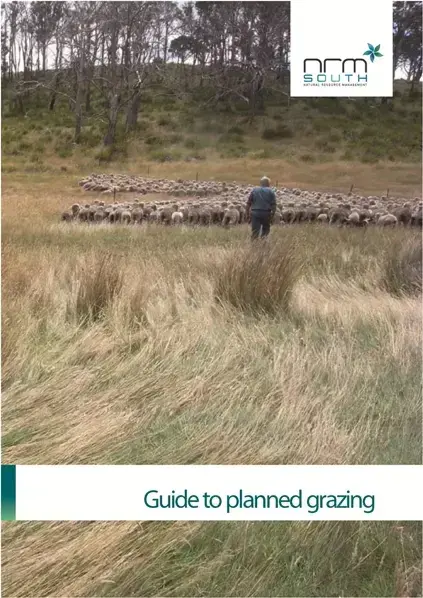 STEP 1: Fence off a small area. Choose your smallest paddock or fence off a corner so that with your mob size the animals are at stockyard densities. For example, if you have sheep in mobs of 500 put them into an area of less than 0.5 ha (1 acre). The closer you can get to stockyard density the less time the stock will need to be in the trial area.
STEP 1: Fence off a small area. Choose your smallest paddock or fence off a corner so that with your mob size the animals are at stockyard densities. For example, if you have sheep in mobs of 500 put them into an area of less than 0.5 ha (1 acre). The closer you can get to stockyard density the less time the stock will need to be in the trial area.
STEP 2: Make a record of the current health of the pasture. It can be helpful to take photos before, during and after this treatment so you can easily monitor any improvement. Take the photo looking straight down from around chest height so that you can see the soil surface.
STEP 3: Add stock. You might need to leave the animals there for as little as four hours, so keep a close eye on your trial area.
STEP 4: Remove stock. It’s important to take stock out at the right time… when the animals have trampled most of the area but the soil surface is still 100% covered either by plants or litter.
STEP 5: Record the date, for how long and how many stock were in the trial area.
STEP 6: Leave the area to recover. It typically takes between 6 and 12 months in temperate regions such as southern Tasmania for the best perennial grasses to recover. Grasses are considered to be recovered when they contain fresh litter (dead leaves still attached to plants) and there is no evidence of previous grazing such as chewed tips.
STEP 7: Repeat the process. By doing this you should continuously improve biodiversity of your pasture and the land function. Recovery time varies with season and from year to year, so you need to keep monitoring and make sure you do not put animals into an area to graze before it is ready, or leave them so long that they create bare ground, otherwise you won’t produce the healthy, diverse landscape you need for your farm. Remember to keep records of stock movements and take photos to see how the length of the recovery time affects your pasture.
NRM SOUTH TRIAL – FULHAM
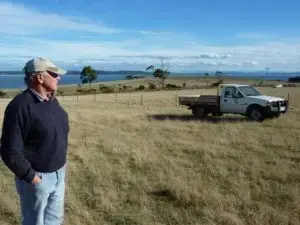
Sandy Gray on Fulham.
Sandy Gray leases his 1000 hectare farm, Fulham, for sheep grazing, but has dedicated a couple of hectares to the NRM South grazing trial. His property falls in the Tasman catchment and is part of NRM South’s priority Tasman Sorell area.
When asked why he decided to adopt the trial Sandy responds, jokingly, “Because they spun me too good a yarn to refuse”.
Jokes aside, ultimately it was the suggestion that sustainable regeneration of the landscape to support production could be achieved without dollar input that piqued Sandy’s curiosity. He had previously attended a course on a similar grazing technique, cell grazing, so was aware of some of the concepts, however his own current management preference is a slow rotation over a small number of large paddocks.
Sandy shows an open interest in the results of the trial, with a half and a full hectare paddock dedicated to the trial. He has also fenced off an additional hectare where he is experimenting with a slightly different rest period to the trial paddocks and monitoring the outcomes for his own interest. He agrees that the trial paddocks are already clearly healthier than those still under conventional methods.

Fulham 1 hectare trial paddock, February 2011 (left) and May 2012 (right) six weeks after 24 hours of 700 sheep grazing. Note improved groundcover and concentration of manure.
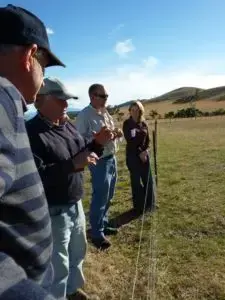
NRM South team members with Sandy Gray.
Observable differences are apparent at Fulham after only 12 months and two grazing periods. The soil in the trial paddocks is softer underfoot and more fibrous, have more litter, healthy regrowth and an even spread of sheep ‘fertiliser’. Thistles are also less than in the ‘control’ paddock, which is subject to slow rotation grazing, where they have seeded in bare soil exposed by over grazing.
Based on the formal monitoring as part of the project, the NRM South 12 month report for Fulham notes, “There is evidence of improvements in both the soils and pastures in the Fulham holistic planned grazing trial site with increases in sown perennials, organic soil carbon, soil water content and decreased bulk density as early as 12 months into the trial. Increases in cover of perennial grasses mean that more of the soil surface will be covered throughout the year where increases in organic carbon improve the ability of the soil to hold water and supply more fuel for soil biological activity”.
Sandy is happy to continue with the trial and is positive about results so far. The lessee is also becoming engaged and is watching the results from the trial activity. Sandy appreciates the support and engagement offered by NRM South and the opportunity to share experiences with other landholders.
MEASUREMENT & MONITORING
NRM South is conducting site specific biophysical monitoring at each trial site with measures of the soil and pasture in the holistic planned grazing trial plots and reference sites (in good condition with similar soil, topographic and vegetation characteristics). This monitoring includes the following methods and is tailored to the test the site-specific landscape changes desired by the landholders:
- Landscape Functionality Assessment (LFA) of treatment and reference/control areas
- Basic soil nutrient analysis (N, P, K, organic C, etc.)
- ScarP soil carbon tests
- Bulk density samples
- Soil compaction
- Soil invertebrate samples
- Tasmanian vegetation condition assessment benchmarks (VCA)
- Permanent transect-guided quadrant-based studies of pastures measuring the relative composition of native perennial pasture species
- Permanent transect-guided quadrant-based studies of pastures measuring presence of exotic annual and perennial pasture species and understorey vegetation
- Density measures of species of interest such as weeds
- Landscape context for farming enterprise (e.g. patch connectivity)
Baseline and 12 month follow up reports have been performed for five properties in collaboration with researchers from the Tasmanian institute of Agriculture. Fifteen of the properties will undergo follow up monitoring in three to five years. First year data for changes in percentage of organic soil carbon and soil water content for the five demonstration trial sites is presented in the graphs below. After the first year, measurement shows that there have been increases in soil organic carbon and soil water content in both planned grazing treatments (0.5 and 1 ha) at Farm 3 and Fulham.
Continued monitoring and activities on demonstration sites helps to maintain engagement with participants and other interested landholders. This helps to maintain enthusiasm and also provides the opportunity to share and discuss results or experiences, contributing to NRM South’s goal of ongoing support and empowerment to landholders in their region.
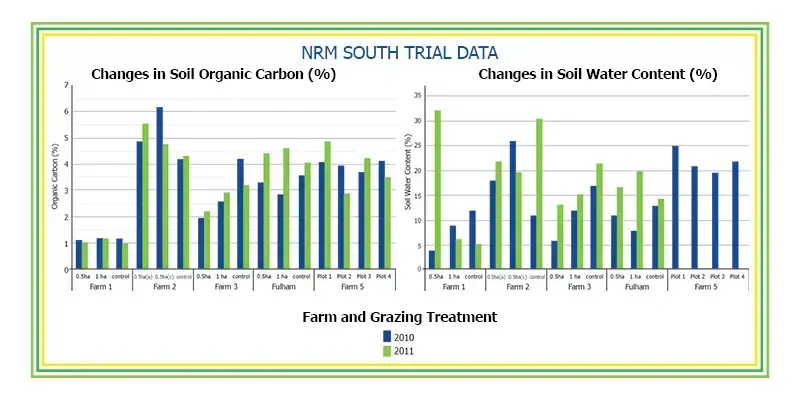
Outcomes
EARLY INDICATORS – TOWARDS SUSTAINABLE OUTCOMES
We are… able to provide support for farmers willing to trial new techniques; those willing to change.
NRM South has encountered some challenges throughout their projects, noting that, “the existing (conventional) agricultural paradigm in Australia does not encourage farmers to trial regenerative farming methods”. They have experienced some resistance from some agronomists, farmers, ecologists and public land managers.
On the whole, however, landholder engagement has been very strong. An independently conducted survey in mid-2011 found that 79% of landholders that NRM South has engaged have gone on to invest additional resources and/or introduce new practices to improve profitability and pasture production and soil health. As Barry notes, “[It is a] challenge to move from linear to holistic thinking, however if it’s worthwhile to the farmers, if they can see money in it, they’ll do it”.
Living Soils activities are attracting increasing interest from landholders, with less advertising and promotion. This program also continues to share the information gained in Building Evidence trials.
In the first 12 months of the Building Evidence trials, changes are already being observed in soil carbon, soil water content and increase biomass and cover of perennial grasses. Due to a good season however, improvements are being seen both on control and planned grazing plots. Across the trial demonstration sites, there are also some site specific changes, and changes vary depending on original practices.
In addition to participating in the trials, some landholders have chosen to trial different practices or methods, seeking their own solutions and evidence – or even trying to disprove the advice NRM South is providing. The team find this positive as it increases farmers’ ownership of results.
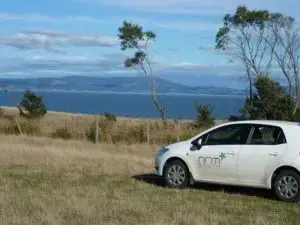
The team at NRM South are achieving positive results from their active and tailored engagement in the region.
The tailored approach taken by NRM South directly addresses other challenges that have been experienced. Magali notes, “There are a lot of learnings from the project, especially that everyone does it differently, with different enterprises and social circumstances which can result in different motivations and impediments”.
“Initially we were collecting purely biophysical evidence, however it is clear that social and economic information is need to have a clear evidence base for farmers interested in regenerative farm practices in southern Tasmania.”
NRM South believes that they are achieving positive outcomes for healthy rural profits, communities and environment with the range of activities they are delivering. Encouraging results include:
- A high interest of landholder engagement for future planned grazing trials and events;
- High participant satisfaction with demonstration field days;
- Three landholders hosting trials have applied techniques beyond the original trial sites;
- Engagement with industry and community groups through field days; and
- Broader communications and recognition outside of Tasmania, such as an invitation to speak at STIPA conference in Holbrook Nov 2011.
In the future NRM South hopes to build redundancy into the delivery of their programs, with the development of communities of practice, or farmer support networks. The increasing demand, evidenced through the numbers attending courses, suggests that this has the potential to become a commercial venture. Some farmer bodies of practice that have been set up elsewhere are self sustaining due to farmers driving and providing educational activities and NRM South would like to explore these options.
As summarised by Barry, “We work with the willing. If landowners are already happy with their production system, we’ll support them in mutually beneficial activities, but, we are better able to provide support for farmers willing to trial new techniques; those willing to change.”
SHARING THE SUCCESS
The projects run by NRM South are encouraging landholders to adopt sustainable land management practices in a low risk way that suits the situation of individual farmers. By using a method based on coordination and cooperation, a range of options are available to assist farmers to change their practices. These provide sufficient ongoing engagement to support changes beyond the initial enthusiasm experienced at field days or workshops.
Landholders are being empowered to understand new techniques at their own pace through the assisted trials. Trial demonstration sites allow for sharing of results and broader discussion and generate interest across the catchment. The landholders are a part of the change, with minimal disruption to their production, and they can choose whether or not to adopt practices based on their own evidence.
The wider adoption of regenerative landscape management is a strategic imperative for Australia’s future well being. Support mechanisms are clearly required to assist land managers who have attended training activities or demonstration days as a means to gain confidence in changing practices. The NRM South case study provides an example of effective techniques to which could be used to provide the required encouragement and support to farmers and land managers to adopt regenerative landscape management practices.



